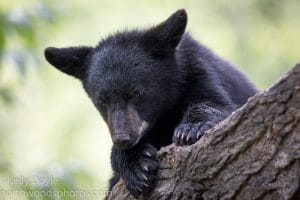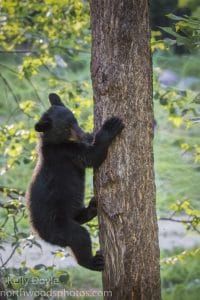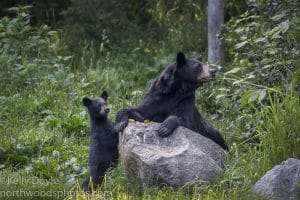One of my favorite Minnesota “locals” are American Black Bears!
There are many misconceptions about Black Bears. People who don’t know any better fear them, thinking that they are out stalking unsuspecting hikers or campers for an ambush attack. In reality, they are pretty timid creatures who go out of their way to avoid encounters with people. I’ve been fortunate enough to volunteer with an expert Black Bear researcher in the past and even got to go into a den (with mama bear still in it – she was tranquilized for the duration). I’ll never forget holding cubs that only weighed 3 pounds and didn’t have their eyes open yet. Let’s get to know them a little better 🙂
Black Bear Facts
For a much more comprehensive list of facts about Black Bears, check out the North American Bear Center site.
- Black Bears in Minnesota hibernate for 5-6 months out of the year. They typically call it a year by late October and emerge from their dens some time in April.
- During hibernation, their heart rates go down to approximately 8 beats per minute and their breathing is almost imperceptible.
- They will lose about a third of their body weight during hibernation – mostly fat. Lactating mothers will lose a bit more, while males and non-lactating females a bit less.
- They do not eat, urinate or defecate during hibernation. Any other mammal would die of kidney failure, but they are somehow able to break down metabolic waste products with no ill effects.
- Their total cholesterol will climb to over 400 mg/dl during hibernation, while their blood lipid profiles are similar to a healthy human during the summer. No evidence of heart disease.
- They give birth to their cubs in January. The cubs are born hairless and weigh less that a pound at birth. Dr. Lynn Rogers installed a camera within a wild Black Bear den several years ago and captured a live birth on video, dispelling the myth that cubs are born while the mother bear sleeps…. lol. You can view it here.
- Once cubs emerge from their dens, one of the first things their mother teaches them is how to climb trees.
- You will not out run or out climb a Black Bear!
Where to see Black Bears
Black Bears are common residents of the North Woods and like the forest. I’ve seen them crossing roads in the Superior National Forest on several occasions, walking next to the highway in St. Louis county, running away from me on hiking trails, and had one that stood up on it’s hind legs to get a better look / sniff at me before it calmly turned around and walked away.
If you want a guaranteed sighting of wild bears, the Vince Shute Wildlife Sanctuary near Orr allows visitors to view bears from an observation deck in the woods. Volunteers at the sanctuary put out natural foods for the bears to eat, luring many wild bears to the grounds. The bears are free to come and go as they please and are not captive in any way. You can learn about how and why this all started by checking out the history. Whether it’s a good idea to continue the practice of feeding the bears is a separate argument.
If you really want to learn from the bear experts, check out the North American Bear Center near Ely. They have several captive bears on site, but the founder did much research with local Black Bears for many years and has first hand knowledge of original studies that had never been done by anyone else. They also have a very educational website!
Black Bear Photos
All of these photos as well as several more are now available for purchase in the Wildlife Gallery! All products are printed using archival inks and materials. Choose from prints, gallery wrapped canvases, or metals.
Bring some North Woods wild into your home or office today!




